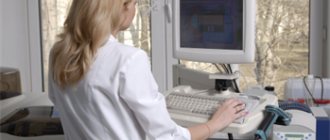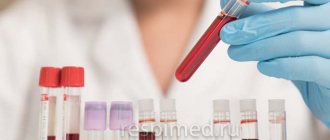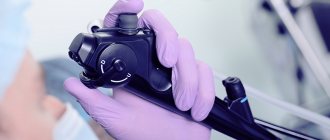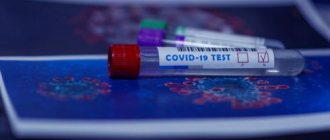Home › Tests and diagnostics › For children › Tests for children › Take a blood test for a child
Make an appointment
Where can I get a blood test done for a child in Ryazan with maximum comfort and reliability? The SM-Clinic Medical Center has its own clinical laboratory and guarantees the accurate conduct of the necessary studies. You can take a blood test for your child both if there are symptomatic indications for examination, and in order to obtain a certificate of health for children's educational and other institutions.
What types of blood tests are there and what are they for?
Blood test in newborns
– prescribed for children from 3 months. Goal: to exclude the development of iron deficiency anemia and check whether the baby is ready for routine vaccinations. If there is the slightest deviation from the norm in the blood test, children are not vaccinated. If there is a hereditary predisposition to certain diseases, a special genetic blood test is performed.
Clinical (general) blood test in children
– the most common blood test. Purpose: to identify inflammatory processes in the body, anemia, the presence of worms, endocrine disorders (ESR). Prescribed to determine/confirm the diagnosis, adjust treatment, and prevent diseases (primarily infectious).
Blood chemistry
– a more detailed study that gives an idea of the state of various organs and systems of the body. It is taken only from a vein.
If necessary, some medical specialists can provide a referral for a blood test for allergens or hormones.
Benefits of a vein blood test
- One sampling allows you to perform more than five different laboratory tests. It is difficult, and sometimes impossible, to collect such a volume from a finger.
- Maximum reliability of the results obtained, extremely low possible error due to the low probability of intercellular fluid entering the biomaterial.
- The child experiences discomfort only when the needle is inserted. When taking blood from a finger, you often have to put in effort and squeeze it out, injuring the tissue and causing pain.
In newborns (before reaching the age of 1 year) and in patients who are overweight or have an increased risk of thrombosis, blood is taken from a finger.
Our clinic employs experienced laboratory technicians and highly qualified nurses. After treating the puncture site with an antiseptic, the hand above this place is carefully tied with a tourniquet, while rough contact with children is excluded; the staff strives to find an individual approach to each child. To take the test, only sterile disposable material is used; the blood is placed in vacuum plastic tubes with precise markings of the child’s individual data, time and date.
What happens to the baby in the treatment room?
A calm, positive atmosphere reigns in the treatment room of our center. Moms and dads have the opportunity to come in with the baby and, during blood sampling, hold him on their lap, hug, kiss, and blow in his ear. The child's attention will be distracted by funny pictures on the walls and bright toys. We do everything to make sure that the children have a pleasant and pain-free experience. For example, instead of conventional scarifying needles to take blood from a finger, we use an expensive new product - lancets . These funny devices, similar to a fountain pen, with a button and a spring, are very popular with little patients. The needles in the lancets have a special sharpening: they pierce the skin almost painlessly and so that the blood flows quickly and you don’t have to press on the finger for a long time. At the end of the procedure, the doctor seals the wound with a plaster with funny faces or animals.
Many mothers are wary of taking blood from a vein. And in vain! Our center employs an experienced procedural doctor who will perform all the necessary manipulations quickly and comfortably for the baby. In winter, for example, this method is preferable: blood will flow from a vein faster than from a cold finger, which means that the baby will have fewer reasons for dissatisfaction.
Our advantages
- Delicate, minimally painful blood sampling for the baby by an experienced and attentive medical professional.
- High accuracy of analysis indicators is the commercial basis of the clinic’s work, which allows us to purchase high-quality reagents, laboratory equipment and the best consumables.
- Increased attention to the psycho-emotional comfort of children. To eliminate possible negativity, we have developed a system of souvenir incentives and other distracting and stimulating activities.
- Quick results - blood tests are performed in the branch’s own laboratory, no time or money is wasted on sending biological material to other specialized medical institutions.
How to properly take blood tests in children?
Doctors almost always ask you to take a blood test in the morning and on an empty stomach . This is not a whim, but a necessity. The fact is that blood taken from the same child at different times of the day may differ in indicators. After eating, the level of leukocytes increases, and after sleep, the level of red blood cells increases. If several blood tests are performed during the treatment period, it is important to perform them under the same conditions: take blood only from a vein or only a finger and at approximately the same time.
When should a child donate blood?
The need to obtain general blood counts arises in the following cases:
- Determining the origin of the symptoms that led to seeking medical help.
- The child is undergoing treatment, and it is necessary to evaluate his current performance in order to continue, stop, or adjust the treatment program.
- You need a certificate for a preschool, educational, health or other institution (swimming pool, kindergarten, school preparation, summer camp, etc.).
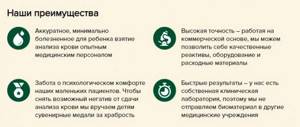
Blood test norms for children
Children's blood test results differ significantly from adults. Moreover, they change every month, even week, especially in the first time after the birth of the baby. And many laboratories still print “adult” numbers on forms. And mothers clutch at their hearts when they discover that hemoglobin is elevated and leukocytes are off the charts. Don’t rush to run for valerian, but just call your pediatrician or come to his appointment. He knows the exact blood test standards for children of every age and will be able to correctly decipher the data obtained. For example, he will tell you that a baby is born with a huge amount of hemoglobin and red blood cells in the blood. Some red blood cells soon disintegrate, causing physiological jaundice in newborns. And this is a completely natural process, most often not requiring medical intervention. But if a child’s hemoglobin has increased during illness, this is a reason not to rejoice, but to urgently give the baby plenty of fluids.
How to properly prepare for the test?
Before donating blood, it is recommended to take measures to avoid increased psycho-emotional stress and physical activity.
It is important to pay attention to the water balance - dehydration or excess moisture in the body can distort the concentration of cells in the blood. To do this, it is enough to ensure that the child follows the drinking regime and is in comfortable temperature conditions. The test is taken in the morning on an empty stomach (at least 7-8 hours must pass after the last meal). In certain cases, a break of at least 4 hours after eating a moderate amount of food may be allowed. If your child is thirsty, you can give him clean drinking water without sugar or gas.
Interpretation of blood tests in children
On the Internet you can find a lot of tables that show the norm of blood counts by age, but this is not the case where independence and fortune telling on coffee grounds are appropriate. Currently, there are several hundred (!) parameters by which blood can be examined, and all of them are important not on their own, but in comparison with each other. Deciphering a blood test requires serious professional training. Our center's pediatricians are always in touch with patients during business hours, and if you purchase our comprehensive health care program, you can call your personal doctor around the clock. You will receive comprehensive and qualified answers to all your questions.
Hello dear parents! I would like to tell you about the rules for preparing a child for a blood test:
A blood test is a good way to get detailed information about a person’s health. However, if a child is to take blood from a vein, it is advisable for parents to prepare their child for this procedure.
Rules for preparing a child for a blood test.
1. Physiological preparation:
Make sure your child's diet matches the required analysis. During a general blood test, you should not feed the child in the morning before the test. Sweet drinks are also contraindicated. But at the same time, it is possible, even recommended, to give him water to drink. When testing blood for various diseases, such as infectious diseases, you should not give your child fried or too salty, sweet or fatty foods for 24 hours before the test.
If possible, choose the right time for analysis. It is better to take it in the morning so that the child does not remain hungry for a long time.
Ideally, the blood of a small patient will be taken not from a finger, but from a vein. The fact is that when drawing blood from a finger, the nurse has to press on the finger. This can lead to hemolysis, the destruction of blood cells in the sample. Due to hemolysis, the test result may be incorrect. In venous blood samples, hemolysis is much less common. Another reason is that any damage to the vessel triggers the blood clotting mechanism.
Venous blood does not come into contact with air and immediately enters the test tube, where it is mixed with an anticoagulant, which prevents the formation of clots. In capillary blood, the risk of microclot formation, which reduces the accuracy of the study, is much higher.
Taking blood from a vein is a safe and virtually painless procedure that does not cause any serious discomfort. Modern disposable vacuum systems for blood collection allow you to take blood very quickly - the child does not even have time to feel anything.
2. Psychological, no less important, preparation:
Before you go for testing with your child, you should talk to him. If the parents remain calm and unperturbed, then the little patient will accept the procedure without fear.
With a child who has already reached preschool or school age, discuss what will happen. You should not scare him, especially if he is donating blood from a vein for the first time.
However, explain that, unlike taking blood from a finger, analysis from a vein takes longer. You can also warn that the child will most likely experience discomfort. In some cases, analogies help. For example, an analysis of sensations can be compared to a mosquito bite. Such comparisons are understandable to the child and help set him up for a calm test.
All preparation of a child for any manipulation should take place through the play method. Only during play can a child relax and accept everything that is told to him. Therefore, if you want to prepare your baby, then try playing “hospital” with him. And as the game progresses, you can have fun exploring the stage of taking tests. And he will no longer seem somehow frightening to the child.
For very young laboratory patients, it is good to use distracting manipulations at the time of blood sampling. For example, attract the child’s attention to some toy. Make sure your child doesn't get bored in line while he or she is waiting for blood to be drawn. Take with you a book, his favorite toy, a coloring book with markers - depending on age. This will not only take up his time, but will also not allow him to concentrate on the fear of the upcoming procedure.
Decide whether your presence in the office during the analysis is necessary. Of course, it will be needed if the child is very small, but for some schoolchildren the presence of parents can only be a hindrance and provoke tears or protest. Focus on the child's psychological characteristics. After the manipulation, give your baby pleasant emotions - hug the baby, do an interesting activity, for example, play or watch your favorite cartoon. Then the negativity from the procedure will quickly be forgotten.
Have a nice day. Sincerely, Kochetkova M.V.
KinderKlinik capabilities
Each KinderKlinik branch has its own laboratory with the following opening hours:
- Branch on the street. Demeevskaya 16 - around the clock, together with the children's hospital
- Branch on the street. Kakhi Bendukidze 2 – from 8 to 20.00
- Branch on the street. Alexandra Mishugi 2 – from 8 to 20.00
- Branch on the street. Vyshgorodskaya 45/2 - around the clock, together with the children's hospital
In addition to basic research (blood, urine, blood biochemistry, etc.), each laboratory also has a wide range of rapid tests to identify:
- intestinal infections: enteroviruses, salmonella
- helminthic infestation
- respiratory viruses: antigens of influenza A and B viruses, adenovirus
- group A streptococci (the most common causative agent of sore throat)
- coronavirus infection
Diagnostic materials are presented in each of the KinderKlinik laboratories, and in the departments on the street. Demeevskaya 16 and st. Vyshgorodskaya 45/2 are available around the clock.
Need an examination?
Sign up
Callback form
Application has been sent, we will contact you soon
Decoding and interpretation of the results of biochemical blood tests
The printout of the results of the study of biochemical parameters provided by the laboratory will indicate the levels of the test substances in the blood plasma and the normative indicators for the child’s age.
The results obtained should be assessed by the pediatrician or medical specialist who ordered the study. Based on the biochemical tests obtained, the doctor will prescribe treatment or suggest additional studies to clarify the diagnosis.
Biochemical studies are an informative, fast and safe method of studying the state of the child’s body and the functioning of individual internal organs and systems, which allows you to accurately establish a diagnosis and carry out the required treatment with maximum efficiency, or get rid of worries and doubts about the state of your baby’s health.
You can get additional information about biochemical studies and sign up for tests at the medical office by calling.
How is blood taken for biochemical studies?
Blood is collected from newborns from the heel by puncturing the skin with a thin children's scarifier. In infants older than one month, blood is taken from the cubital vein.
In all cases, the nurse treats the surface of the skin with an antiseptic spray or solution. To increase the amount of blood in the vein before the study, it is briefly clamped with a tourniquet (soft tourniquet). Then a thin needle is inserted into the vein, through which the blood flows into a test tube or syringe. After blood collection, the injection site is treated with an antiseptic, and a bandage or plaster is applied to it.



